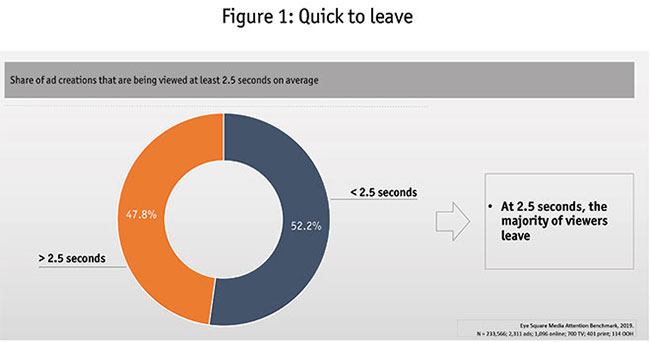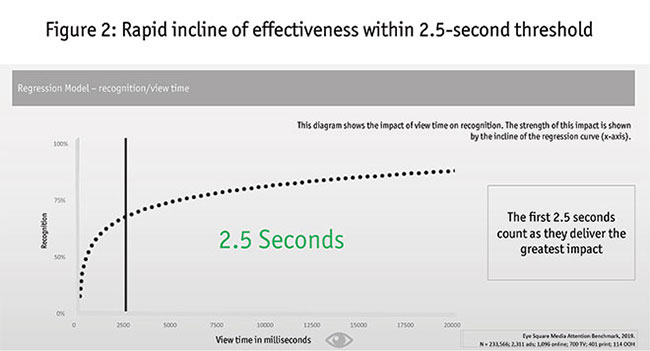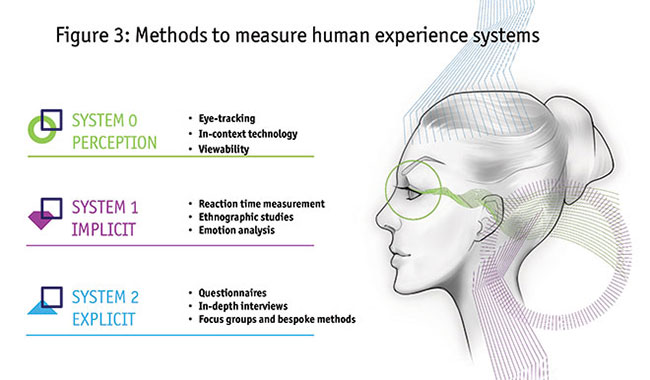The eyes have it
Editor's note: Michael Schiessl is CEO of research firm Eye Square. Philipp Reiter is the company’s COO. Jan-Philipp Görtz a content advisor for Eye Square. Jeff Bander is Eye Square’s head of U.S.
In the first half of the 20th century, still dominated by Johannes Gutenberg’s printing press, it seemed sufficient in market and other social research to simply ask people’s opinions in order to find out what their actions would be. The time of this “explicit” research (or System 2) was one of print ads, billboards, posters and newspapers, which in the interwar period added the cinema and radio (broadcast and advertisement). It was a brave old world of “rational thinking,” analogue technology to go with conventional, black-and-white pictures with some radio sounds. Print media especially have an almost captive audience, as the process of reading words from analogous media requires active participation and limits readers’ ability to digress.
This Gutenberg universe was subsumed by television in the 1960s. TV integrates visual and audio information into one powerful medium with the potential to monopolize attention of an increasingly passive audience. Furthermore, due to its ability to tell stories with color, motion and sound, television reaches deeper into the emotional spheres (System 1). This, the emotional drama of TV, is the motive behind implicit research to gauge emotional responses and effects. Together System 1 and 2 (emotion and cognition) cover roughly 80 percent of a person’s experience. So far, so good.
What about the remaining 20 percent? Actually, it seems to be becoming more important in communications. The last 15 years have seen yet another revolutionary development and with it the dawn of a new era: the mobile internet and screen revolution made possible by powerful networks and numerous new tech devices. Multiple new and less-linear media choices have become available for users and consumers. In their wake the human experience has become even more fragmented and fast-paced. Content and advertising are merging into a deluge of information and entertainment that threatens to overwhelm users, consumers, advertisers and media companies alike.
The onslaught of content can be seen from the results of a study we undertook in recent years: the EyeSquare Media Attention Benchmark. For this we analyzed the results of hundreds of studies, with more than 230,000 participants, across more than 2,300 ads and creations (about 1,100 were online, 700 TV, 400 print and more than 100 out out-of-home). The result: Only 10% of advertising contacts last longer than eight seconds. This shows changing viewing habits, which are a consequence of multiplying media options. Whereas in former media eras it was either System 1 or System 2 that were the “limit to experience,” it now appears that it is almost sheer human perceptive capacity (the senses – especially the visual sense or perception) that is a prime limiting factor (gate) to experience and communication. We call this gate System 0 and it matters more than ever: Whatever meets the eye may get in; what doesn’t definitely won’t. There is competition to get through this gate, a gate that up to now has been taken for granted. It forms the basis for the other two systems to even get involved.
Thus, this revolution has created its own crisis of the understanding of the effectiveness of communication and advertising – and cries out for innovation in research and analysis, in psychology and even philosophy. Fortunately, the digital revolution has also brought technologies to explore and analyze these experiences with new power, exactness and capacity.
Define and improve
Basically, System 0 is a psychological construct based on physiological data. It helps to define and improve measurement and description of perception. The interaction of System 0 with System 1 and 2 is decisive: Without System 0 there is no System 1 or 2. However, System 0 is itself not abstract but rather concrete yet individual. System 0 is especially meaningful for measuring the combination of iconic effects with the use of syntax and semantics. Whatever performs worse on the surface of the retina has a lot of catching up to do.
We have formulated three theses regarding the new paradigm that we call “System 0 – key gate to the digital experience.” They are: the highly complex digital human experience requires a new analytical model; understanding System 0 is more important than ever; and advanced technology and research methods make System 0 insights possible.
1. The highly complex digital human experience requires a new analytical model.
The digital revolution entails a revolution of experience. What seemed forgotten – namely that the human being is neither simply rational nor emotional but also sensual – comes to the fore.1 All together form the human person. It is also evident that what is not received in some form by the human senses is beyond our experience. For the “information economy” to become real it needs to pass through what one might call the “attention economy.” There are essentially five senses, of which smell is the most individually diverse, whereas sight tends to be most evenly developed among individuals.2 It is also the sense that is most affected by our visual media culture.3 And while a sensual experience may never enter our emotional or conscious levels – or at least not immediately – it still impacts our behavior.
Nevertheless, the senses were never much of a study object – only for their medical pathologies. They were taken for granted while the rational and later the emotional spheres were seen as decisive for human behavior and experience. That may have been more reasonable in a one-medium environment, where media stimuli enter the funnel of our senses in a more orderly fashion. But this changes in a nonstop, multiscreen and multimedia environment like today’s. Senses are almost constantly exposed to a barrage of stimuli. And the funnel’s function – namely, actual attention (perception) – becomes more exclusive. Consequently, the attention being paid to a certain stimulus (a picture or ad) has become considerably shorter.

As we see from Figure 1, most attention4 today is extremely short – a precious gift, often amounting to less than 2.5 seconds.5 However, urban myths like “human attention is now shorter than that of a goldfish” are not supported by data. Instead, it is rather a consequence of the many visual options in today’s media environment. And with such an abundance of stimuli available to the average viewer, it is not surprising that the first human filter – sight (the one “on the frontlines” of visual experience and preceding emotions and cognition) – becomes more and more important. Because what is not perceived is not experienced – and thus cannot be effective. As communication is supposed to have an effect, failure to be perceived means failure to communicate.6
2. Understanding System 0 is more important than ever
Given what’s at stake – namely the success of your communication – and given the fact that System 0 is the increasingly crowded gate for information to enter into our emotional and cognitive systems, it is evident that understanding how this gate operates is a key to understanding the whole human experience today. It is also evident that acting upon this knowledge will be the key to successfully passing System 0 and entering recall/memory and the subconscious and conscious decision-making centers of users and consumers.
As the actual usage of devices (especially in a multiscreen/touchpoint situation) and their ability to impact us is as of yet not sufficiently understood, many important questions – such as how to build brands in this context – remain open. Our studies give some insights, however. The most basic: There is no need for despair or trusting mere good fortune. The first 2.5 seconds of a contact deliver massive effect for later recognition of an ad’s content (Figure 2). They are therefore precious. And they can and should be utilized. As these first seconds become more important, though, questions arise regarding the way advertising is created, placed and sold. System 0 is the new frontier of successful communications. And understanding it is the key to being successful.

3. Advanced technology and research methods make System 0 insights possible
Advances in technology are not limited to media and entertainment, though. Research technology and methods for understanding perception have also improved a lot. Before the mobile/multi-screen revolution, mere technological indicators – such as clicks – served as proxies for attention. However, an active click is not enough because it often falls short of actual viewability. Viewability itself is a better indicator already and, importantly, is a standardized international measurement belonging to the System 0 arsenal. However, in and of itself it lacks conclusive explanatory power, as the “visible” information or visual might not connect with the retina of the viewer.7 The mere fact that a stimulus is “viewable” on what may now be one of many screens for some number of seconds does not mean it is actually “viewed,” i.e., perceived. While viewability is of course the “hard” precondition for perception, nothing less than an actual view is necessary for real contact and communication to take place.
Thus, mere performance orientation must be amended to become deeper and more precise. This requires new technological and intellectual approaches, such as combining eye-tracking technology with databases that can decipher the correlation between views and action, such as conversions. Studies such as our firm’s Media Attention Benchmark found strong correlations between dwell time (“information intensity”) and recognition, for example.
This important information shows that as actual attention (openness of the gate) per stimulus and creation decreases, information must become more intense, i.e., creations with a higher information density and speed will be more successful in the new era. Creation is key. And iconic, bold creations, which are most dense, may actually press a message through the gate and into the decision-making process despite high volume. Successful creation will take this into consideration and needs some type of measurement itself.
Three factors
At Eye Square we combine all three systems in an in-context environment into our analyses (Figure 3). Our work regarding an understanding of System 0 focuses on three factors, their roles in the process of visual perception and the impact on Systems 1 and 2: machine (context and performance) – “the ability of the machine”/viewability; human action – eye movement, scrolling, zapping; and the stimulus (passive) – the object itself (especially the property of the stimulus in the respective medium, i.e., in context).

In the context of visual sense, measurability is relatively high, constant and dependable. In addition, there are international definitions for metrics such as viewability. These measuring tools, definitions and standards can be compared. For example, this would allow for a comparison between viewability and actual eye-tracking in order to establish a difference in predictive precision. Theoretical models could be developed from that.8
Our goal is to embed System 0 tests into browser tools – to put theory into code, so to speak. One potential application would be an online tool that calculates the quality of a stimulus/creation in context using viewability data and eye-tracking benchmark data. Right now, technology is more static than dynamic but integration of and into programmatic (even though programmatic itself has weaknesses) should become possible.
Ultimately, an integration of System 0 into the analysis will allow for an improved understanding of human experience – with better tools, faster, more agile and less resource-intensive testing and consulting. An improved understanding of the precious first seconds will help media producers and advertisers better appreciate attention, not take it for granted and reward it instead. Users and consumers, in return, will reward their efforts.
Goes full circle
Understanding, accepting and owning the challenge of intensity will go a long way to success in the new era of communication. It may be that, as the human species grows into this new era, it reverts to the primitive (yet information-dense) communication via icons, symbols, images – and thus goes full circle back to the times of hunters and gatherers who needed to perceive laterally and act quickly in order to survive. Attention in this context is like a fast orientation in a confusing environment. While it does not work like emotion and reason, it does not contradict them. Instead, it amends their utility.
If the less dense yet more sophisticated emotional and cognitive layers can be involved, this can actually lead to a more holistic way of being and communicating, one that transcends the limits of mere rational or emotional communication prevalent in the last (industrial) century with its linear communication. One that goes a longer way to understanding human experience and ultimately to getting more than you can see.
References
1 The “homo digitalis” is homo economicus, homo sentimentalis and homo sensualis.
2 https://today.duke.edu/2013/12/hiroodor. For explanations on the sense of smell: www.sciencedirect.com/topics/neuroscience/olfaction. For vision: www.brainfacts.org/thinking-sensing-and-behaving/vision.
3 In 2019, time spent with media by U.S. adults averaged 12 hours and nine minutes per day, a number that will have increased during pandemic times. Digital (mostly visual, some visual and audio) 6:35h, TV (visual and audio) 3:35h, radio (audio) 1:20h, print (visual) 0:20h. www.emarketer.com/content/us-time-spent-with-media-in-2019-has-plateaued-with-digital-making-up-losses-by-old-media
4 Understood here as visual perception.
5 EyeSquare Media Attention Benchmark - www.eye-square.com/en/media-attention-benchmark/
6 https://insider.integralads.com/viewability-ad-effectiveness-publishers-need-know/
7 For a further discussion of the elements of (visual) effectiveness in the case of video ads and possible ad effectiveness metrics based on visual factors see Reiter, Schiessl, Thölke, et al, in: “Stay tuned! Assessing the effectiveness of social media ads.” Marketing Review St Gallen, 3/2016, pp 10ff.
8 This might become necessary, as tracing-data/cookies are increasingly wiped out as people refuse/delete cookies, etc. Empirical data needs to be complemented with theoretical knowledge.
